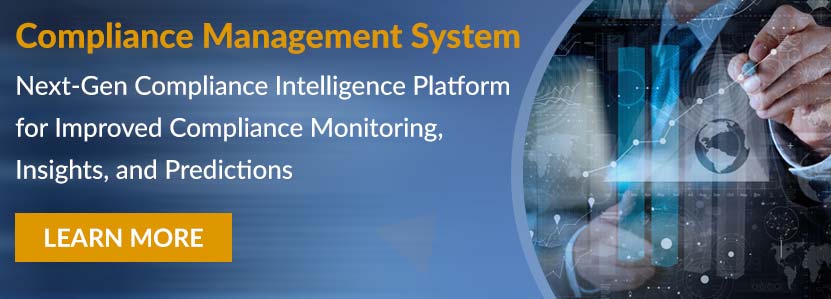Home/ Blog / Improving Enterprise Compliance Management in 4 steps
Enterprise compliance management remains a challenging domain for most businesses. Organizations are often reacting to compliance issues instead of proactively handling the compliance framework to eliminate the root causes of non-compliance. We are known for our compliance expertise and have helped multiple organizations improve compliance management and turn the compliance department into an asset that helps them improve the way their organization operates. Here are the 5 steps a business needs to take to do the same:

Enterprise compliance management remains one of the most critical functions for businesses operating in heavily regulated industries like finance. Businesses in heavily regulated industries need to comply with multiple sets of regulations which are often updated or amended. This means that enterprise compliance management is a continuous function, where businesses focus on ensuring that all their employees have the right training and all their policies have been updated to comply with the latest regulatory changes. Compliance management technology makes the job easier for financial organizations by automating some of the most frustrating parts of the compliance and streamlining workflows.
Step 1 – Standardize Compliance Data
Data is now considered one of the most important assets that any organization can have. Data has insights and trends in it which can unearth new opportunities and warn you about emerging risks and threats. However, data can only provide these benefits if it is properly analyzed. This analysis isn’t possible in most organizations due to the disparate and disarrayed nature of compliance information. Important compliance information is often shared only in documents and anyone who wants to analyze the data needs to first extract it then standardize it so it can be compared with data from another source.
Standardizing all compliance information streamlines the process and makes it easier for the compliance department to slice and dice the data and view it in different analytical contexts. This process allows the compliance team to discover problematic trends and hidden opportunities in compliance. This is one of the key components of our compliance solution – it ensures data standardization and then uses the data to provide executive intelligence.
Step 2 – Centralize Compliance Communication
A lack of interdepartmental communication can result in a lot of delays in compliance programs. A compliance team can only nip problems in the bud if they become aware of the compliance issues as they are discovered. There needs to be a centralized platform which allows all departments to collaborate on compliance issues. Discussing compliance issues through emails is an inefficient process resulting in long threads among many different people. These email threads cause audit issues because it is difficult for the auditors to collect all the information from multiple email threads about the same issue.
A centralized compliance platform eliminates all these inefficiencies and streamlines enterprise compliance. This is the approach we have taken in Predict360 Compliance Management Solution – the solution doesn’t just help compliance managers gain a better grasp over compliance, it also provides a platform for the other departments to provide details and updates on compliance issues. All this information is made instantly available to all compliance stakeholders which fosters collaboration and allows businesses to proactively deal with compliance issues.
Proper compliance activity management is a game-changer for proactive compliance programs. When someone sees a compliance issue on their dashboard, they can instantly click on it to create a task and assign it to someone in the compliance team. Share on XStep 3 – Real-time visibility
Step 1 ensures that all the compliance data is in a usable state and step 2 ensures that the data is being shared quickly. The next step is to enable real-time visibility of compliance issues and analysis. This has long been a need for compliance teams working in small and medium-sized organizations. Although larger enterprises have invested millions of dollars to enable real-time visibility, smaller organizations have traditionally been limited by investment costs.
The good news is that as technologically advances it becomes more accessible and its costs go down as well. The same has happened to compliance technology. Compliance solutions like our Predict360 solution are now available on a subscription-based cloud model. These solutions provide executive dashboards that provide everyone a real-time view of compliance issues, KPIs, trends, and much more. Real-time visibility is essential for any business that wants to handle compliance issues proactively.
Step 4 – Compliance Activity Management
Detecting compliance issues is only half the battle. Efficient compliance programs focus on fixing compliance issues quickly as well. A compliance activity management solution helps foster a culture in which issues are immediately handled by the compliance team and the departments affected by the compliance issue. Email is not an efficient way to discuss compliance activity management and, as we discussed previously, causes a lot of audit issues.
Proper compliance activity management is a game-changer for proactive compliance programs. When someone sees a compliance issue on their dashboard, they can instantly click on it to create a task and assign it to someone in the compliance team. This activity is shared with all the assigned stakeholders. Managers can view the status of all compliance activities throughout the organization and intervene whenever required.
Step 5 – Increase accountability and ownership
Once you have all the right compliance tools and processes in place you can start focusing on managing the compliance culture. Managing compliance activities through a platform ensures that there is a proper audit log for every action taken on a compliance issue. Make sure that all compliance issues are assigned to the right team members from every department and keep track of the progress being made. It is difficult to accomplish this when the compliance program is based on manual processes, but if you introduce automation and streamlined workflows into the process, it becomes achievable very quickly.
These 5 steps will help to ensure compliance efficiency while providing you with new compliance issues and trends.
Request a Demo
Complete the form below and our business team will be in touch to schedule a product demo.
By clicking ‘SUBMIT’ you agree to our Privacy Policy.




